heating CITROEN DS3 CABRIO DAG 2015 Handbook (in English)
[x] Cancel search | Manufacturer: CITROEN, Model Year: 2015, Model line: DS3 CABRIO DAG, Model: CITROEN DS3 CABRIO DAG 2015Pages: 404, PDF Size: 13.93 MB
Page 26 of 404

DS3_en_Chap01_controle-de-marche_ed01-2014
Warning lampis oncau seAction / Observations
di
esel engine
pre-heating fixed.
The
 key  is  at  position  2  (ignition  on)  in Â
t
he  ignition  switch.Wait
 until  the  warning  lamp  goes  off  before  starting.
The
 period  of  illumination  of  the  warning  lamp  is Â
d
etermined  by  the  climatic  conditions  (up  to  about Â
t
hirty  seconds  in  extreme  climatic  conditions).
If
 the  engine  does  not  start,  switch  the  ignition  off  and Â
t
hen  on,  wait  until  the  warning  lamp  goes  off  again, Â
t
hen  start  the  engine.
Parking brake fixed. The
 parking  brake  is  applied  or  not Â
p
roperly
 r
eleased.Release
 the  parking  brake  to  switch  off  the  warning Â
l
amp,  keeping  your  foot  on  the  brake  pedal.
Observe
 the  safety  recommendations.
For
 more  information  on  the  parking  brake,  refer  to  the Â
c
orresponding
 s
ection.
Stop & Star t fixed. When
 the  vehicle  stops  (red  lights,
 t
raffic  jams,  ...)  the  Stop  &  Start  system
 h
as  put  the  engine  into  STOP  mode.The
 warning  lamp  goes  off  and  the  engine  restarts Â
a
utomatically  in  START  mode,  as  soon  as  you  want  to Â
m
ove  off.
flashes for a few
seconds,
 then  goes Â
o
f f.STOP
 mode  is  temporarily Â
u
navailable.
or
START
 mode  is  invoked Â
au
tomatically.For
 more  information  on  special  cases  with  STOP Â
m
ode  and  START  mode,  refer  to  the  "Stop  &  Start" Â
s
ection.
Page 74 of 404
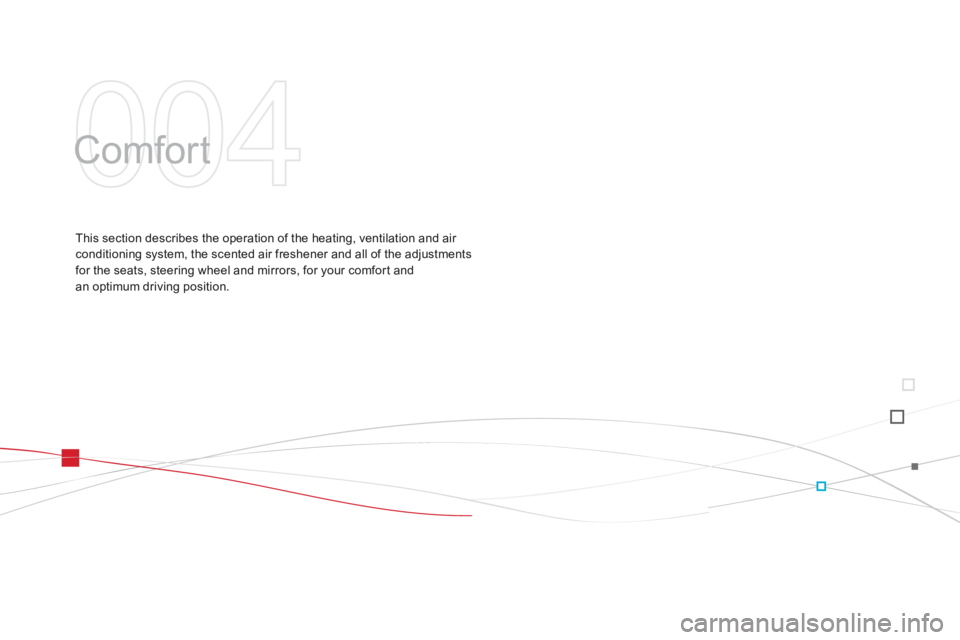
DS3_en_Chap04_confort_ed01-2014
Comfort
This section describes the operation of the heating, ventilation and air conditioning  system,  the  scented  air  freshener  and  all  of  the  adjustments Â
f
or  the  seats,  steering  wheel  and  mirrors,  for  your  comfort  and Â
a
n  optimum  driving  position.
Page 77 of 404
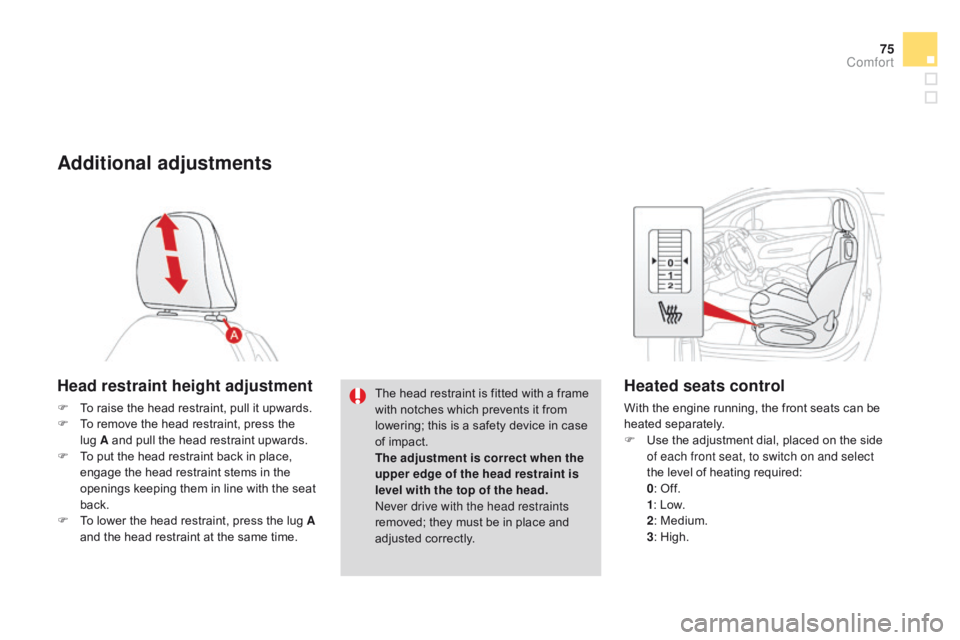
75
DS3_en_Chap04_confort_ed01-2014
Additional adjustments
Head restraint height adjustment
F To raise  the  head  restraint,  pull  it  upwards.
F  T o  remove  the  head  restraint,  press  the Â
l
ug  A  and  pull  the  head  restraint  upwards.
F
Â
T
o  put  the  head  restraint  back  in  place, Â
e
ngage  the  head  restraint  stems  in  the Â
o
penings  keeping  them  in  line  with  the  seat Â
b
ack.
F
Â
T
o  lower  the  head  restraint,  press  the  lug  A
and
 the  head  restraint  at  the  same  time.The
 head  restraint  is  fitted  with  a  frame  w
ith  notches  which  prevents  it  from Â
l
owering;  this  is  a  safety  device  in  case Â
o
f  impact.
The adjustment is correct when the
upper edge of the head restraint is
level with the top of the head.
Never drive with the head restraints
removed;
 they  must  be  in  place  and Â
adj
usted
 c
orrectly.
Heated seats control
With the engine running, the front seats can be heated s eparately.
F
Â
U
se  the  adjustment  dial,  placed  on  the  side Â
o
f each front seat, to switch on and select
the
 level  of  heating  required:
0:
 Off.
1:
 Low.
2:
 Medium.
3:
 High.
comfort
Page 85 of 404

83
DS3_en_Chap04_confort_ed01-2014
Ventilation
Air intake
The air circulating in the passenger compartment is  filtered  and  originates  either  from  the  outside  via t
he  grille  located  at  the  base  of  the  windscreen  or
 f
rom  the  inside  in  air  recirculation  mode.
Air treatment
The incoming air follows various routes depending  on  the  controls  selected  by  the Â
d
river:
-
Â
d
irect  arrival  in  the  passenger Â
c
ompartment  (air  intake),
-
Â
p
assage  through  a  heating  circuit  (heating),
-
Â
p
assage  through  a  cooling  circuit  (air Â
c
onditioning).
The
 temperature  control  enables  you  to  obtain Â
t
he  level  of  comfort  required  by  mixing  the  air  of Â
t
he  various  circuits.
The air distribution control enables you to
diffuse
 the  air  in  the  passenger  compartment Â
c
ombining  several  air  vents.
The air flow control enables you to increase or
reduce
 the  speed  of  the  ventilation  blower.
control panel
The controls of this system are grouped together  on  control  panel  A on the centre
console.
 Depending  on  the  model,  the Â
f
unctions  offered  are:
-
Â
t
he  level  of  comfort  required,
-
a
ir flow,
-
a
ir distribution,
-
 d
emisting-defrosting,
-
Â
m
anual  or  digital  air  conditioning  controls.
Air distribution
1. Windscreen demisting-defrosting v ents.
2. F ront  side  window  demisting-defrosting Â
ve
nts.
3.
 S
ide  adjustable  air  vents.
4.
 C
entral  adjustable  air  vents.
5.
 A
ir  outlets  to  the  front  footwells.
6.
 A
ir  outlets  to  the  rear  footwells.
comfort
Page 87 of 404
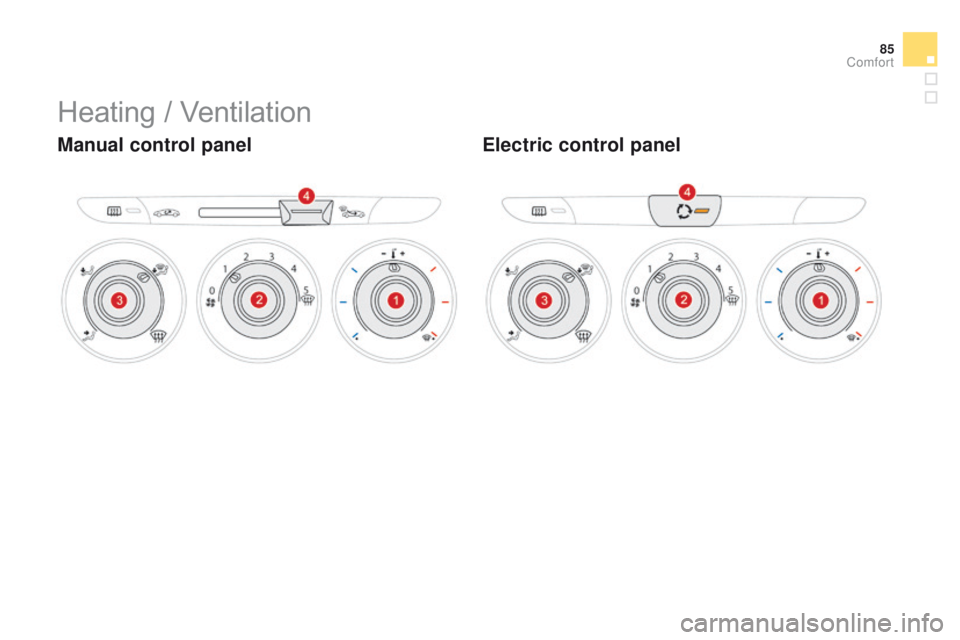
85
DS3_en_Chap04_confort_ed01-2014
Heating / Ventilation
Manual control panelElectric control panel
comfort
Page 89 of 404

87
DS3_en_Chap04_confort_ed01-2014
The heating / ventilation or air conditioning systems operates with the engine running, as well as in STOP mode with Stop & Start.
1. Temperature adjustment
F Turn the  dial  from  blue  (
cold)  to  red  (hot)  to  adjust Â
t
he  temperature  to  your Â
r
equirements.
2. Air flow adjustment
F Turn  the  dial  from  position  1
to position 5 to obtain a
comfortable
 air  flow.
F
I
f you place the air flow control
in position 0 (deactivation of the
system),
 the  temperature  is  no Â
l
onger  maintained  at  a  comfortable Â
l
evel.  However,  a  slight  flow  of  air, Â
d
ue Â
t
o Â
t
he Â
m
ovement Â
o
f Â
t
he Â
v
ehicle, Â
c
an  still  be  felt.
3. Air distribution adjustment
Windscreen and side windows.
W indscreen, side windows and
footwells.
Footwells.
Central
 and  side  vents.
The air distribution can be
adapted
 by  placing  the  dial Â
i
n  an  intermediate  position.
4. Air intake / Air recirculation
The intake of exterior air avoids the formation of  mist  on  the  windscreen  and  side  windows.
The recirculation of interior air insulates the
passenger
 compartment  from  exterior  odours Â
a
nd  smoke.
Return
 to  exterior  air  intake  as  soon  as  possible Â
t
o prevent deterioration of the air quality and
the
 formation  of  mist.
Manual control panel F
Â
M
ove  the  manual  control  to Â
t
he  left  to  be  in  the  "recycling Â
i
nterior  air"  position.
F
Â
M
ove  the  manual  control  to  the Â
r
ight  to  return  to  the  "fresh  air Â
i
ntake" Â position.
comfort
Page 91 of 404

89
DS3_en_Chap04_confort_ed01-2014
Front demist - defrost
With the heating /
ventilation system
F Put the  temperature  and  air  flow  controls  to  t
he  dedicated  marked  position.
F
Â
P
ut  the  air  intake  control  to  the  "Exterior  air Â
i
ntake" Â position Â
Â
(
manual  control  to  the  right  or  electric Â
c
ontrol  with  indicator  lamp  off).
F
P
ut the air distribution control to the
"Windscreen"
 p
osition.
These
 markings  on  the  control  panel  indicate  the  control  positions  for  rapid  demisting  or  defrosting  of  the  windscreen  and  side  windows.
With the manual air
conditioning system
FÂ Put
 the  temperature  and  air  flow  controls  to  t
he  dedicated  marked  position.
F
Â
P
ut  the  air  intake  control  to  the  "Exterior  air Â
i
ntake" Â position Â
Â
(
manual  control  to  the  right  or  electric Â
c
ontrol  with  indicator  lamp  off).
F
P
ut the air distribution control to the
"Windscreen"
 p
osition.
F
Â
S
witch  on  the  air  conditioning  by  pressing Â
t
he "A /
c"Â
button;  the  associated  green Â
w
arning  lamp  comes  on. With
 Stop  &  Start,  when  the  demisting, Â
a
ir  conditioning  and  air  flow  functions  a
re  activated,  STOP  mode  is  not  a
vailable.
comfort
Page 93 of 404
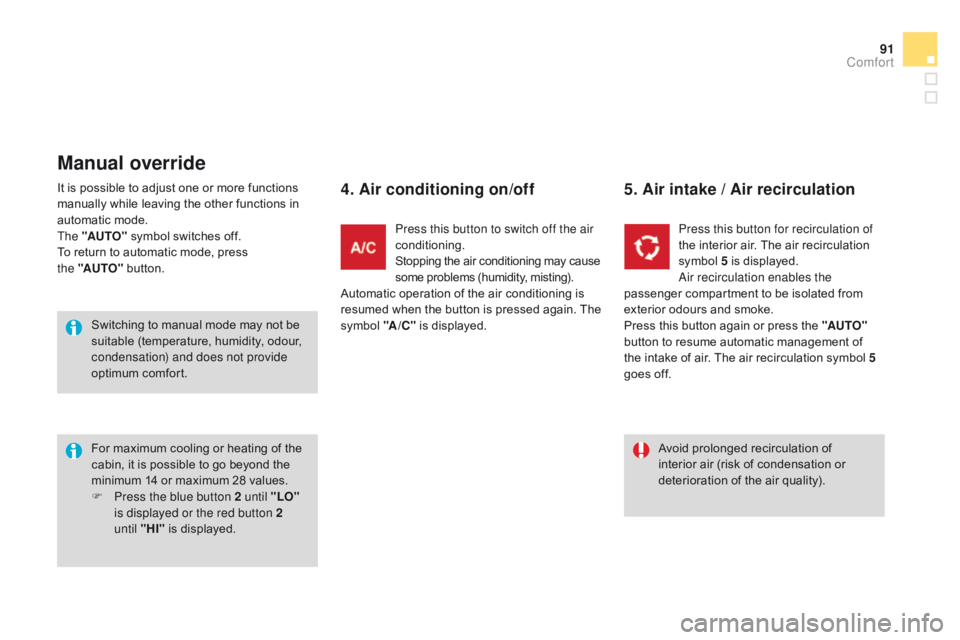
91
DS3_en_Chap04_confort_ed01-2014
It is possible to adjust one or more functions manually  while  leaving  the  other  functions  in Â
a
utomatic  mode.
The "AUTO"
Â
symbol  switches  off.
To
 return  to  automatic  mode,  press Â
the "AUTO"
Â
button.
Manual override
4. Air conditioning on/off
For maximum cooling or heating of the cabin,  it  is  possible  to  go  beyond  the Â
m
inimum  14  or  maximum  28  values.
F
P
ress the blue button 2 until "LO"
is displayed or the red button 2
until
"HI"
Â
is  displayed. Press this button to switch off the air
conditioning.
Stopping
 the  air  conditioning  may  cause
 s
ome  problems  (humidity,  misting).
Automatic  operation  of  the  air  conditioning  is Â
r
esumed Â
w
hen Â
t
he Â
b
utton Â
i
s Â
p
ressed Â
a
gain. Â
T
he Â
s
ymbol
 "A
/
c"Â
is  displayed.
5. Air intake / Air recirculation
Press this button for recirculation of
the
 interior  air.  The  air  recirculation Â
s
ymbol
 5
 is  displayed.
air
recirculation enables the
passenger
 compartment  to  be  isolated  from Â
e
xterior
Â
odours  and  smoke.
Press
Â
this
 button  again  or  press  the  "AUTO"
button
Â
to
Â
resume  automatic  management  of Â
t
he
Â
intake
 of  air.  The  air  recirculation  symbol  5
goes
Â
off. Avoid
 prolonged  recirculation  of Â
i
nterior  air  (risk  of  condensation  or Â
d
eterioration  of  the  air  quality).
Switching
Â
to
Â
manual
Â
mode
Â
may
Â
not
Â
be
Â
s
uitable
Â
(temperature,
Â
humidity,
Â
odour,
Â
c
ondensation) and does not provide
optimum
 c
omfort.
comfort
Page 95 of 404
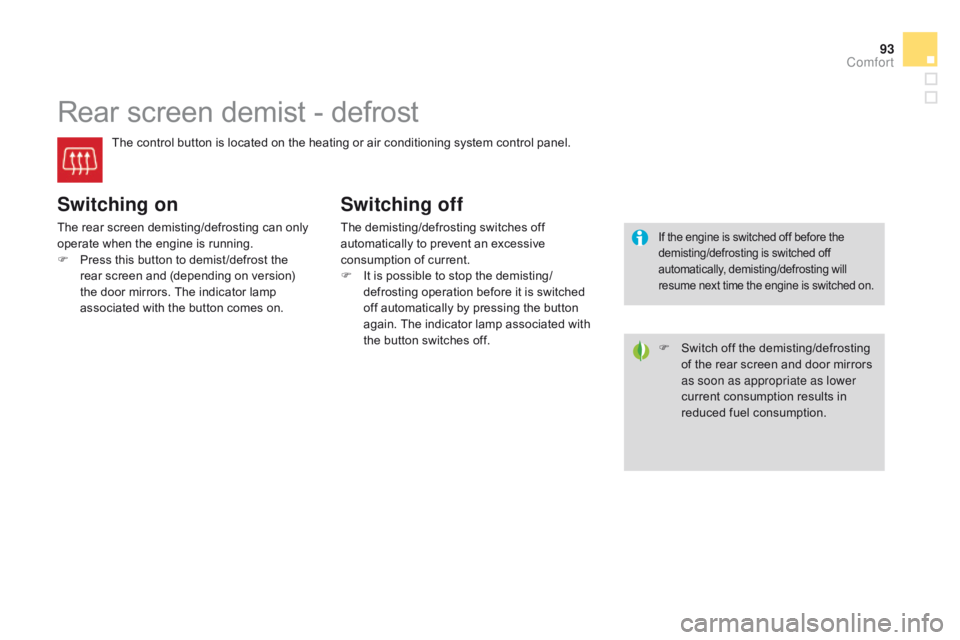
93
DS3_en_Chap04_confort_ed01-2014
Rear screen demist - defrost
The control button is located on the heating or air conditioning system control panel.
Switching on
The rear screen demisting/defrosting can only operate  when  the  engine  is  running.
F
Â
P
ress  this  button  to  demist /defrost  the Â
r
ear  screen  and  (depending  on  version) Â
t
he  door  mirrors.  The  indicator  lamp Â
a
ssociated  with  the  button  comes  on.
Switching off
The demisting/defrosting switches off automatically  to  prevent  an  excessive Â
c
onsumption  of  current.
F
Â
I
t  is  possible  to  stop  the  demisting/
defrosting
 operation  before  it  is  switched Â
o
ff  automatically  by  pressing  the  button Â
a
gain.  The  indicator  lamp  associated  with Â
t
he  button  switches  off. F
Â
S
witch  off  the  demisting/defrosting Â
o
f  the  rear  screen  and  door  mirrors Â
a
s soon as appropriate as lower
current
 consumption  results  in Â
r
educed
 f
uel
 c
onsumption.If the engine is switched off before the demisting/defrosting  is  switched  off a
utomatically,
 d
emisting/defrosting
 w
ill
 r
esume  next  time  the  engine  is  switched  on.
comfort
Page 241 of 404
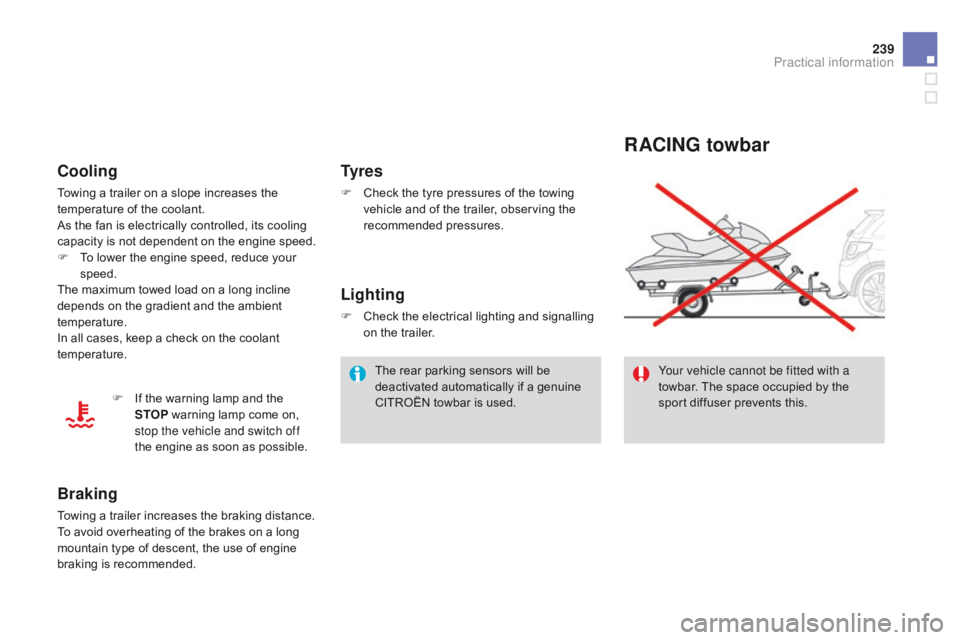
239
DS3_en_Chap10_info-pratiques_ed01-2014
RAcING towbar
Your vehicle cannot be fitted with a
towbar. The  space  occupied  by  the Â
s
port  diffuser  prevents  this.
Ty r e s
F Check the  tyre  pressures  of  the  towing  v
ehicle  and  of  the  trailer,  observing  the Â
re
commended
 p
ressures.
cooling
Towing a trailer on a slope increases the temperature  of  the  coolant.
As
 the  fan  is  electrically  controlled,  its  cooling Â
c
apacity  is  not  dependent  on  the  engine  speed.
F
Â
T
o  lower  the  engine  speed,  reduce  your Â
s
peed.
The
 maximum  towed  load  on  a  long  incline Â
d
epends  on  the  gradient  and  the  ambient Â
t
emperature.
In
 all  cases,  keep  a  check  on  the  coolant Â
t
emperature.
Braking
Towing a trailer increases the braking distance.
T o  avoid  overheating  of  the  brakes  on  a  long Â
m
ountain  type  of  descent,  the  use  of  engine Â
b
raking  is  recommended.
Lighting
F Check  the  electrical  lighting  and  signalling  o
n  the  trailer.
The
 rear  parking  sensors  will  be Â
d
eactivated  automatically  if  a  genuine Â
C
ITROËN  towbar  is  used.
F
Â
I
f
Â
the
Â
warning
Â
lamp
Â
and
Â
the
Â
S
TOP
Â
warning
Â
lamp
Â
come
Â
on,
Â
s
top the vehicle and switch off
the
Â
engine
Â
as
Â
soon
Â
as
Â
possible.
Practical information